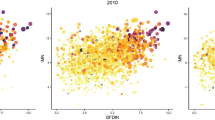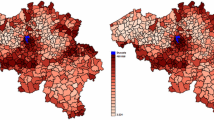Abstract
This paper examines the nonmarket interactions among migrants in the urban labor market of Bangkok, Thailand. We test whether the population size and the labor-market performance of previous migrants have externalities to new migrants who have moved from the same province of origin. Our empirical results, which control origin fixed effects, time fixed effects, and origin- and year-specific correlated shocks, show that (1) the relative population size of previous migrants in the market decreases the employment probability of new migrants (substitution effect), (2) the employment probability of previous migrants increases that of new migrants (positive externalities), and (3) when the employment probability of previous migrants is high, however, the scale effect becomes positive, which demonstrates a threshold in the informational scale economies. The results imply that positive informational scale effect dominates negative substitution effect when the efficiency of previous migrants is sufficiently high in the destination labor market.



Similar content being viewed by others
Notes
From an analytical point of view, the exclusive focus on this large city avoids the potential heterogeneities of the labor-demand structure.
Conley and Udry (2004) explicitly use information flows among neighbors in their study of Pineapple adoption. Behrman et al. (2002) also examine contraceptive decisions incorporating social networks that respondents reported in their survey.
For migrants’ assimilation process and their wage dynamics, for example, see Yamauchi (2004).
It also shows that the variance of the employment probability is large if the relative size is small. Though we do not examine this phenomenon in this paper, part of this variation must be attributable to sampling errors that may arise from the small samples in the case of relatively small migrant shares.
The table shows the pseudo R squared in the Probit estimation. It is assumed that a perfect fit gives log likelihood of zero. Given that the model of the only constant gives \(\ln L=a\), the pseudo R squared in the table is \(\left({l{\hat{n}}L}-a\right) /(-a)\). See Veall and Zimmermann (1996) for details of various methods.
The share of migrants from other provinces in the total population of migrants is perfectly correlated with that of migrants from the same origin in the population. Therefore, we did not include this variable in this robustness check. Another variable we are potentially interested in is the share of Bangkok natives (those who have stayed more than 9 years). However, as all these variables are by construction perfectly correlated with the round-year fixed effects, we conclude that the fixed effects contain all these factors. Hence, for the purpose of the robustness check, we decided not to include the Bangkok-native variables.
References
Banerjee B (1983) Social networks in the migration process: empirical evidence on chain migration in India. J Dev Areas 17(2):185–196
Behrman JR, Kohler H, Watkins SC (2002) Social networks and changes in contraceptive use over time: evidence from a longitudinal study in rural Kenya. Demography 39(4):713–738
Borjas G (1995) Ethnicity, neighborhood and human-capital externalities. Am Econ Rev 85(3):365–390
Caces F, Arnold F, Fawcett J, Gardner R (1985) Shadow household and competing auspices: migration behavior in the Philippines. J Dev Econ 17(1–2):5–17
Case A (1992) Neighborhood influence and technological change. Reg Sci Urban Econ 22(3):491–508
Case A, Katz L (1991) The company you keep: the effect of family and neighborhood on disadvantaged youth. NBER Working paper No.3705
Foster AD, Rosenzweig MR (1995) Learning by doing and learning from others: human capital and technical change in agriculture. J Polit Econ 103(6):1176–1209
Manski C (1993) Identification of endogenous social effects: the reflection problem. Rev Econ Stud 60(3):531–542
Montgomery JD (1991) Social networks and labor market outcomes: toward an economic analysis. Am Econ Rev 81(5):1408–1418
Munshi K (2003) Networks in the modern economy: Mexican migrants in the U.S. labor market. Q J Econ 118(2):549–597
Munshi K, Myaux J (2005) Social norms and the fertility transition. J Dev Econ (in press)
O’Regan K, Quigley J (1996) Teenage employment and the spatial isolation of minority and poverty households. J Hum Resour 31(3):692–702
Schultz TW (1975) The ability to deal with disequilibria. J Econ Lit 13(3):827–846
Topa G (2001) Social interactions, local spillovers and unemployment. Rev Econ Stud 68(2):261–295
Veall MR, Zimmermann KF (1996) Pseudo-R\(^{2}\) measures for some common limited dependent variable models. J Econ Surv 10(3):241–257
Yamauchi F (2004) Are experience and schooling complementary? Evidence from migrants’ assimilation in the Bangkok labor market. J Dev Econ 74(2):489–513
Yamauchi F (2005) Social learning, neighborhood effects, and investment in human capital: evidence from green revolution India. J Dev Econ (in press)
Acknowledgments
We would like to thank Masahito Kobayashi and two anonymous referees of the Journal and seminar participants at the 2003 Population Association of America Annual Meeting, Minneapolis for valuable comments. We are grateful to the International Centre for the Study of East Asian Development (ICSEAD) for financial support. All remaining shortcomings are ours.
Author information
Authors and Affiliations
Corresponding author
Additional information
Communicated by Responsible editor: Klaus F. Zimmermann
Rights and permissions
About this article
Cite this article
Yamauchi, F., Tanabe, S. Nonmarket networks among migrants: evidence from metropolitan Bangkok, Thailand. J Popul Econ 21, 649–664 (2008). https://doi.org/10.1007/s00148-006-0072-0
Received:
Accepted:
Published:
Issue Date:
DOI: https://doi.org/10.1007/s00148-006-0072-0




